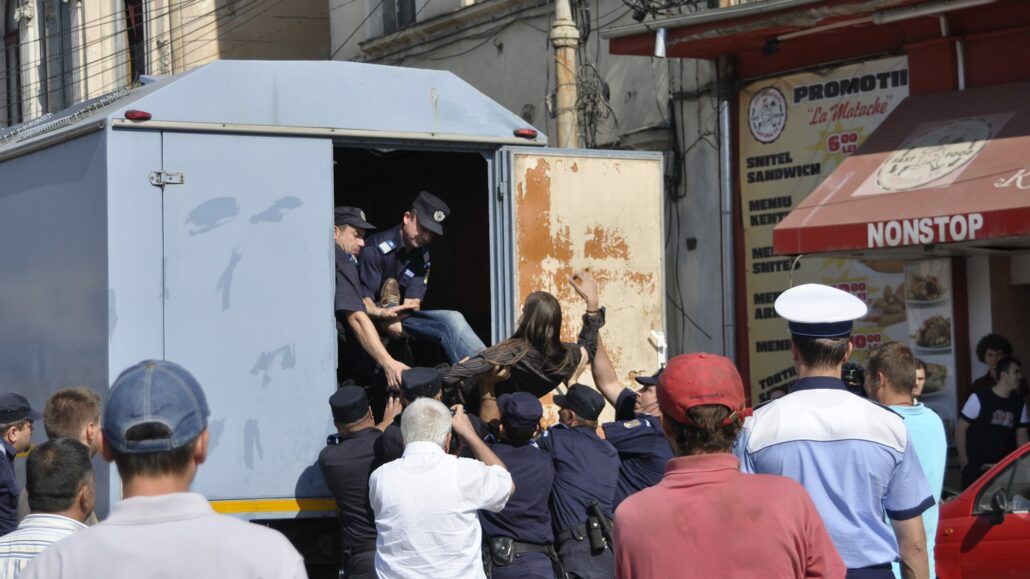Text: Mugur Grosu
Photo: Alexandru Oglindă
Six Frenchmen get off the plane and start following a bunch of football fans, thinking they will lead them to the stadium. They reach a pub in the old town where the others start drinking. A couple of beers later they realize that the supporters were not Hungarians but Ukrainians, and what they thought was Budapest was in fact another capital that had once dreamed itself to be Little Paris, one of the hosts of this peculiar European Football Championship which has sent the fans on a fool’s errand through 11 European cities. The press was delighted by the news, as usual. The hilarity can continue, even if some claim this is fake news. In any case, the confusion stops at the name: nothing would entitle a confusion between Dâmbovița and the Danube, and the relationship of the two cities with the rivers that cross them, or between the Parliament Palace – former House of the People and the Parliament in Budapest, or Országház – House of the Country. Our former House of People and Parliament should be renamed the House of the SPP (Protection and Guard Service), as the visitors of MNAC (National Museum for Contemporary Art), housed in the same Ceausescu Palace, are well aware, since you can’t enter the museum with a trivial pair of scissors in your backpack, even though using it to dig through the walls towards the Parliament would take you decades, just like those poor Turkish prisoners who dug the well at Corvin Castle.
There are several reforming urban regeneration projects about breaking through that wall surrounding the hill of horrors; some are politically supported, others approved in principle. But so far not a single brick has moved.
In fact, the place is just a necropolis with draconian security – a word that in Greek means city of death: this hill is a “city of death of the city”, and I’m not just talking about the former Uranus neighbourhood, levelled to the ground, filled with concrete and now adorned with a cathedral on top, like a cherry on a huge cake. All the evils of the country seem to lead here, and a previous mayor even started to make them a boulevard – shamelessly named Uranus. This is how the necropolis expanded, on the ruins of the old neighbourhood on Berzei-Buzești, with its famous Matache market hall. This summer marks 10 years since the so-called Peace of Matache, when the butcher-mayor publicly promised to give up the demolition of the hall and make peace with the architects and civil society. Then he changed his mind. And one winter night, during a full-blown amber weather alert, he demolished it. Then he gravely pledged again: “I will move it exactly 37 meters and 20 centimeters further. I’m not being funny, that’s the exact distance.” This was another thing that went up in smoke… I used to live in the area, my balcony overlooked the market. I was fascinated by that urban fabric, like an honest street food with everything on top, where you could find layers of the society that otherwise do not associate, nor mingle too much. At Buzești no. 5 there was an almost invisible plaque stating that in 1882 the famous couple Mihai Eminescu and Veronica Micle lived there for a while. There were stories that the place had eluded communist demolition because the writers had set up a human chain around it. However, it did not escape Oprescu’s boulevard. I too wanted to start a human chain, around Matache Hall, when it was rumoured again that it would be demolished. We never had the chance, we were picked up by the police van for the mere intention to protest. As it happened, I was the first to be picked up. They threw us in the meat wagon like sacks of potatoes. Activist Nicușor Dan was already a celebrity, so he was handled with kid gloves. Down at the station, a policeman wanted to prove that he knew me too: “Mr. poet, want to have a poetry contest? I can do poetry too”. I made a wisecrack and said, “No, you’ll kick my ass.”
The activist is now incumbent mayor. Although it looks like he’s still in the process of getting settled in his new position. There is still a wall between us and the authorities, and it is not just the one on the hill of horrors: the wall that pushes us back continuously is that of a self-sufficient discretionary power, one that is 37.2 meters thick. Tear down this wall! And let’s have peace once and for all.
*photo: Mugur Grosu at Piața Matache – Bucharest, 10th of June 2012; photo by Alexandru Oglindă


